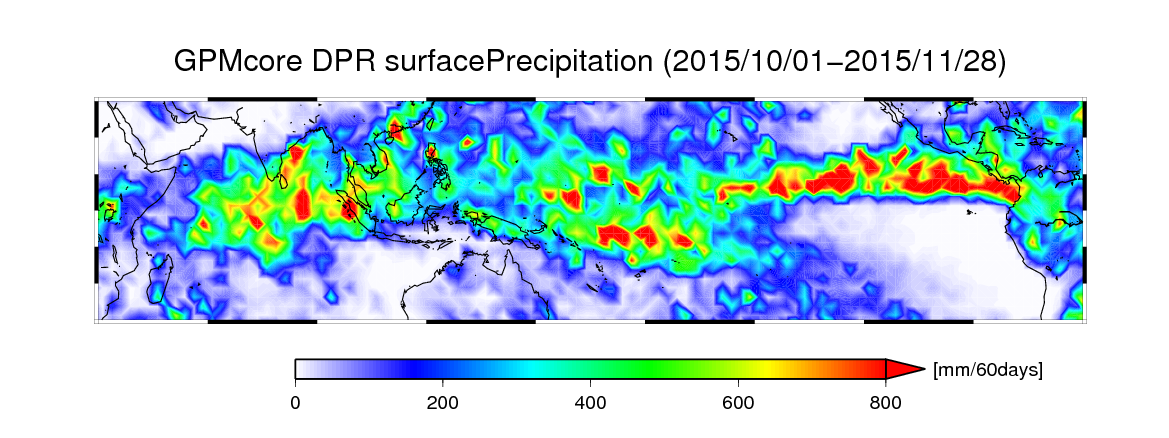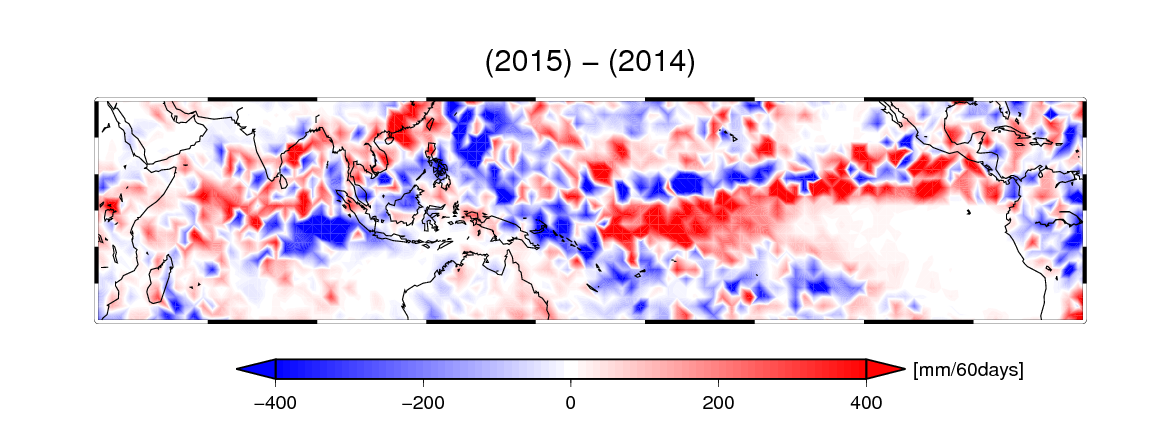


















The largest El Nino in observation history (since 1950) occurred in 1997/98, and the magnitude of El Nino in 2015 approached the same magnitude. According to the Japan Meteorological Agency on November 10, 2015, a difference of + 2.7 ° C from the reference sea surface temperature (SST) value was recorded in the El Nino monitoring area in October, representing the largest value since 1997.
During El Nino, SST in the low middle–eastern equatorial Pacific rises higher than usual, due to weak trade winds on the equator. La Nina is the opposite phenomenon to El Nino, and both phenomena occur at sea. Satellites record their generation and disappearance; in particular, the microwave radiometer can transmit information obtained through clouds, measure the SST below, and make frequent observations, even in tropical sea areas where large scale convection systems develop. Figure 1 shows SST from the Indian Ocean from November 21 to 25, 2015, observed by the Advanced Microwave Scanning Radiometer 2 (AMSR2) loaded on the Global Change Observation Mission–Water (GCOM-W) satellite "Shizuku" launched by JAXA. The boxes in the figure indicate El Nino monitoring areas. Using only this figure, it is difficult to determine whether SST is higher than usual, but Figure 2 shows differences from usual SST values for the same period. The light blue to green colors represent almost normal SSTs, but red indicates higher than usual SSTs and blue indicates the opposite state. It can be seen from this figure, that SST was 3 ° C higher than usual over a wide range of the middle and eastern Equatorial Pacific. Figure 3 shows changes in average SSTs from 2002 to 2015 for NINO.3, which is one of the El Nino monitoring areas.

Figure 1. SST distribution in tropical Indian Ocean–Pacific Ocean from 21 to 25 November 2015, observed by AMSR2.

Figure 2. Same as Figure 1. but showing distribution of the difference between actual SST obtained by AMSR2 and average SST according to the Japan Meteorological Agency.

Figure 3. Time variation in difference between actual and average SSTs from NINO.3 obtained between June 2002 and November 2015.
As the distribution of SST changes with El Nino, the area where strong convection occurs in the tropics also changes, which subsequently causes alterations in the distribution of atmospheric circulation fields and precipitation. Figure 4 shows the distribution of ground surface precipitation integrated from October 1 to November 28, 2015, as observed by the two-frequency precipitation radar (DPR) loaded on the global precipitation observation (GPM) main satellite. Figure 1 shows an area with high SSTs, which indicates a large amount of precipitation. Figure 5 shows differences in integrated ground surface precipitation between 2015 and 2014. Considerably more precipitation fell in 2015 compared with 2014, as respectively indicated by the red and blue colored areas. The area in which the amount of precipitation increased underwent an expansion in response to the strong El Nino in the Middle East Equatorial Pacific in 2015, and a reduction in precipitation in the oceanic continents can be seen, such as near Indonesia. These changes in the atmosphere and ocean also cause abnormal weather patterns; for example, the start of the rainy season was delayed by El Nino to after July in 2015 in Indonesia, but when it began there was an inadequate amount of precipitation to extinguish the extensive forest fires, which were the largest ever recorded. Normally, the effects of El Nino are the strongest in winter in the Northern Hemisphere, and continual future monitoring of associated weather patterns is necessary.

Figure 4. Integrated ground surface precipitation distribution from October 1 to November 28, 2015 recorded by DPR loaded on GPM main satellite.

Figure 5. Same as Figure 4, but showing difference in distribution between integrated ground surface precipitation recorded by DPR in 2015 and that in 2014.
 Example of use by years
Example of use by years